Louisiana’s coastal marshlands form an ideal habitat for numerous fascinating creatures that inhabit the shores and surrounding water bodies. These wetlands run 10,400 square miles, nearly 40% of the salt marshes in the contiguous United States. The deposition of sediments transported by the mighty Mississippi River plays a crucial role in forming these coastal wetlands.
Over the past 7,000 years, the river has been instrumental in creating seven deltas within central and eastern Louisiana. As the river meanders and alters its course, new marshlands emerge while others undergo erosion and disappear. These dynamic processes continuously shape the ever-changing landscape of Louisiana’s coastal marshes.
This article focuses on one of the deserted island marshes, the Last Island – a series of barrier islands stretching 90 miles from the Mississippi River’s mouth. You’ll learn about the Island’s history, how it became deserted, and the numerous creatures that lurk in its marshlands. We’ll also explore conservation efforts underway to preserve the biodiversity at the Last Island.

The Isolated Isle: A Haunting Beauty
Isle Dernière, commonly known as Last Island, is a composite barrier island along the Gulf of Mexico. Positioned to the south of Dulac and between Lake Pelto, Caillou Bay, and the Gulf of Mexico, this Island earned its name as it marks the concluding barrier island in a series that originates at the mouth of the Mississippi River.
The Last Island was home to over 100 beach houses, resorts, and gambling dens in the 1800s. It was such a popular winter destination among the wealthy that there was a regular steamer service between the mainland and the Island.
In 1856, a potent hurricane swept through southern Louisiana, destroying all structures on the island. Two hundred of the roughly four hundred people on the Island died. The destruction was so severe that humans never inhabited the Island again.
Isle Dernière: An Ecological Paradise Lost
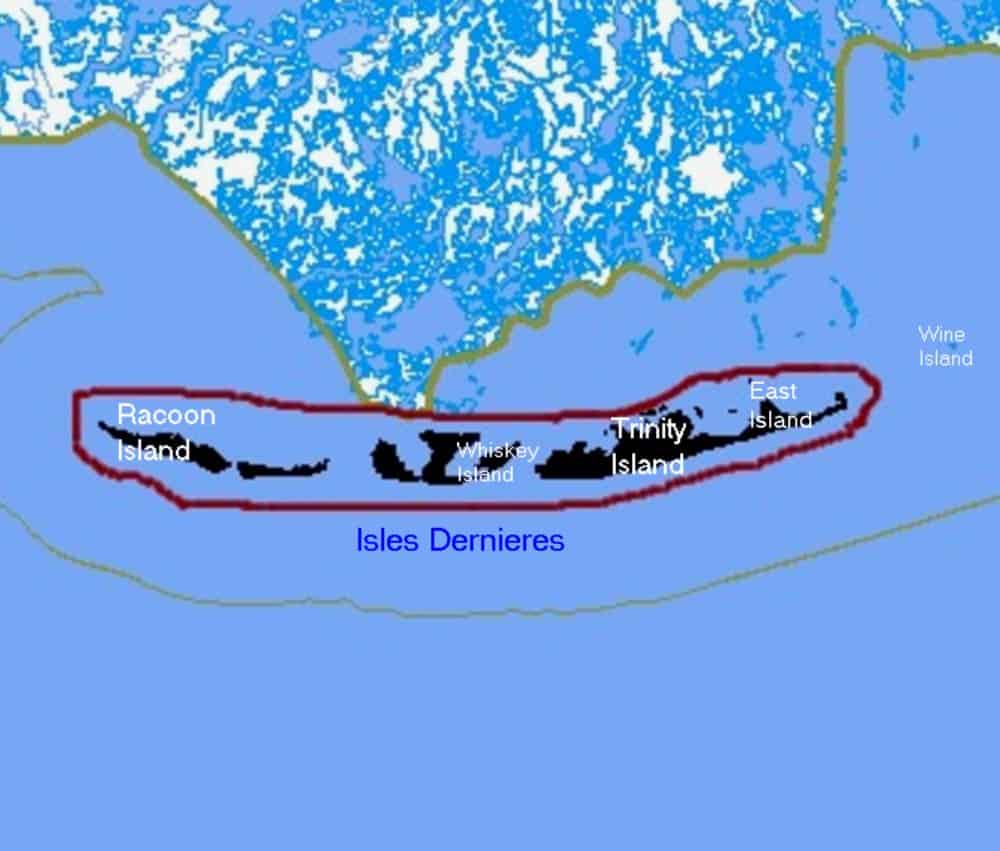
Hurricanes broke the barrier island further into five isolated islands – Whiskey, Trinity/East, Raccoon, and Wine Islands.
©en:User:sf46, Public domain, via Wikimedia Commons – License
With human absence, the Island has become a haven for diverse and distinct animal life. Subsequent hurricanes broke the barrier island further into five isolated islands– East, Whiskey, Trinity, Raccoon, and Wine Islands.
Under the jurisdiction of the Louisiana Department of Wildlife and Fisheries, the collection of islands comprises the Isle Dernière Barrier Islands Refuge. This refuge provides a sanctuary for an array of water birds, including pelicans and seagulls, which utilize the area for breeding purposes. The refuge’s sandy shores also support various other creatures, creating a habitat that sustains multiple species.
Where is Isle Dernière Located on a Map?
The 24-mile-long Isle Dernière can be found 5 miles south off the coast of Louisiana, southwest of New Orleans, and 15 miles south of Cocodrie. It is between Lake Pelto, Caillou Bay, and the Gulf of Mexico. It can only be accessed by boat and while there is a public use area on Trinity Island, public access to the island is prohibited unless permission is granted by the Secretary of Louisiana Department of Wildlife and Fisheries (LDWF).
The following species of animals call this island home:
Eastern Brown Pelican
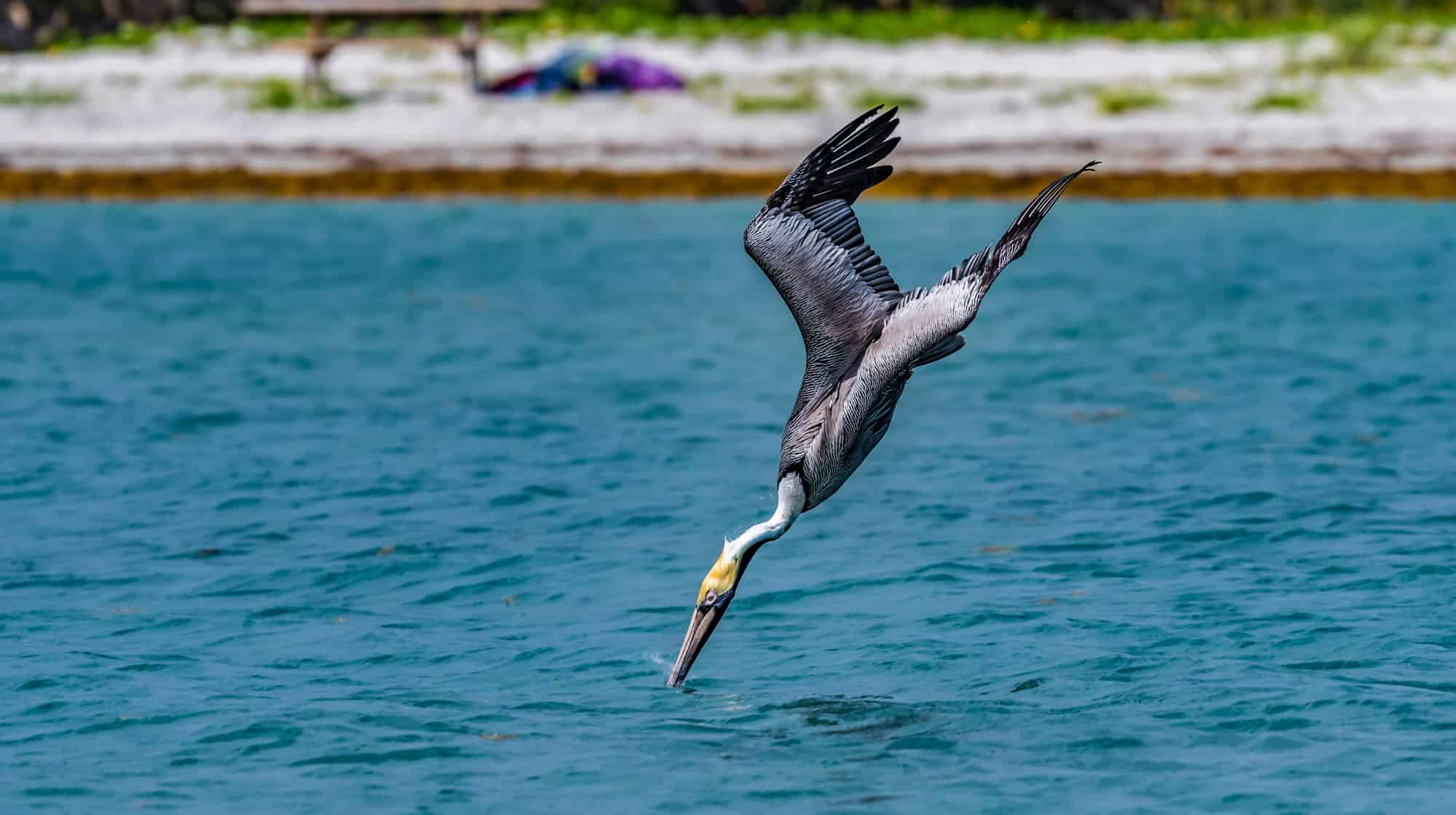
The brown pelican hunts by flying as high as 100 feet and plunging 30-60 feet for a catch.
©mark smith nsb/Shutterstock.com
The Atlantic and Gulf coasts are home to the brown pelican (Pelecanus occidentalis). These bird species are at risk of extinction. It is one of two species that feed by diving into the water and is Louisiana’s official state bird.
The eastern brown pelican has a brownish-gray body and a white head with a pale yellow patch on its crest. It weighs roughly 4.4 to 11.0 pounds, with a wingspan of approximately six to seven feet. Brown pelicans have a large throat pouch and a lengthy 18-inch bill.
The brown pelican hunts by flying as high as 100 feet, scanning for fish. Once it spots a fish, the bird swoops in, plunging 30 to 60 feet, bill-first, for a catch. While the impact typically kills an ordinary bird, the pelican has air sacs below its skin that cushion the blow. The large pouch can hold over 2.5 gallons, with the bird draining the water before tossing its head back to swallow the fish.
American Alligators
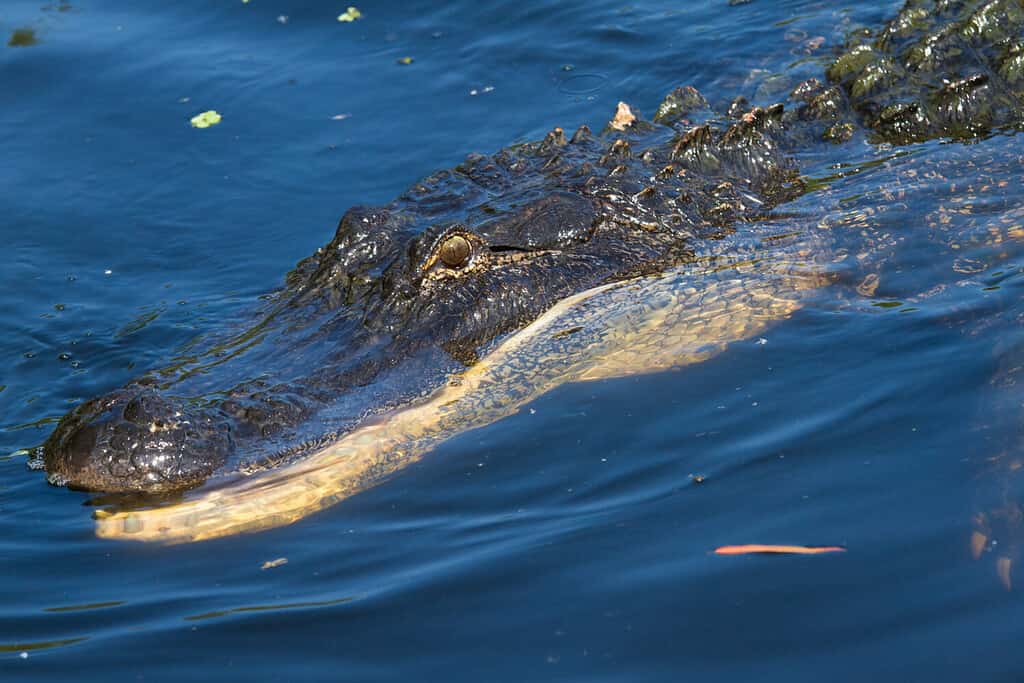
Louisiana boasts an immense
alligator
population that has significantly soared in the last 50 years.
©Sasha Craig/Shutterstock.com
The American alligator is a giant crocodilian reptile with a robust physique, short legs, and a lengthy, brawny tail. Louisiana boasts an immense alligator population that has significantly soared in the last 50 years: from slightly below one hundred thousand to over two million, as documented by Louisiana’s Department of Wildlife & Fisheries.
The skin of the American alligator has embedded bony plates that create a solid protective armor. Its large, rounded snout and upward-facing nostrils can immerse its entire body in the water.
Despite primarily inhabiting freshwater environments, brackish water, coastal marshes, and estuaries are suitable habitats for the American alligator. Though they lack salt glands, gators can tolerate salty water in nearshore coastal wetlands, including Last Island.
Kemp’s Ridley Sea Turtles
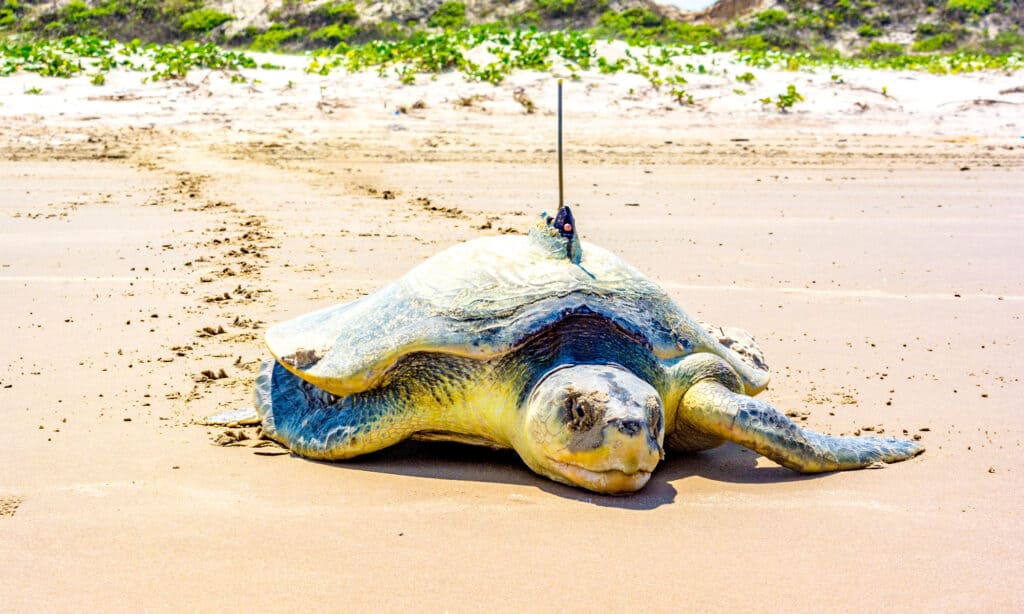
Kemp’s ridley sea turtles almost went extinct in the 1960s,
©JB Manning/Shutterstock.com
Kemp’s ridleys are the smallest turtles in the world. Currently listed as a U.S. endangered species, the turtle reaches maturity at 23–28 inches in carapace length and weighs roughly 79–99 pounds. The turtles feed on fish, crabs, clams, and seaweed.
Adults live primarily on the Gulf of Mexico coast, foraging the shallow waters of the continental shelf. In 2022, the Kemp’s Ridleys hatched on the barrier islands along Louisiana’s coast for the first time in 75 years.
The Kemp’s ridley sea turtles almost went extinct in the 1960s, with less than 200 nesting females remaining. Stringent protection laws on fishing and preservation of nesting sites have increased the turtle population to roughly 7,000–9,000 nesting individuals.
Black Skimmer
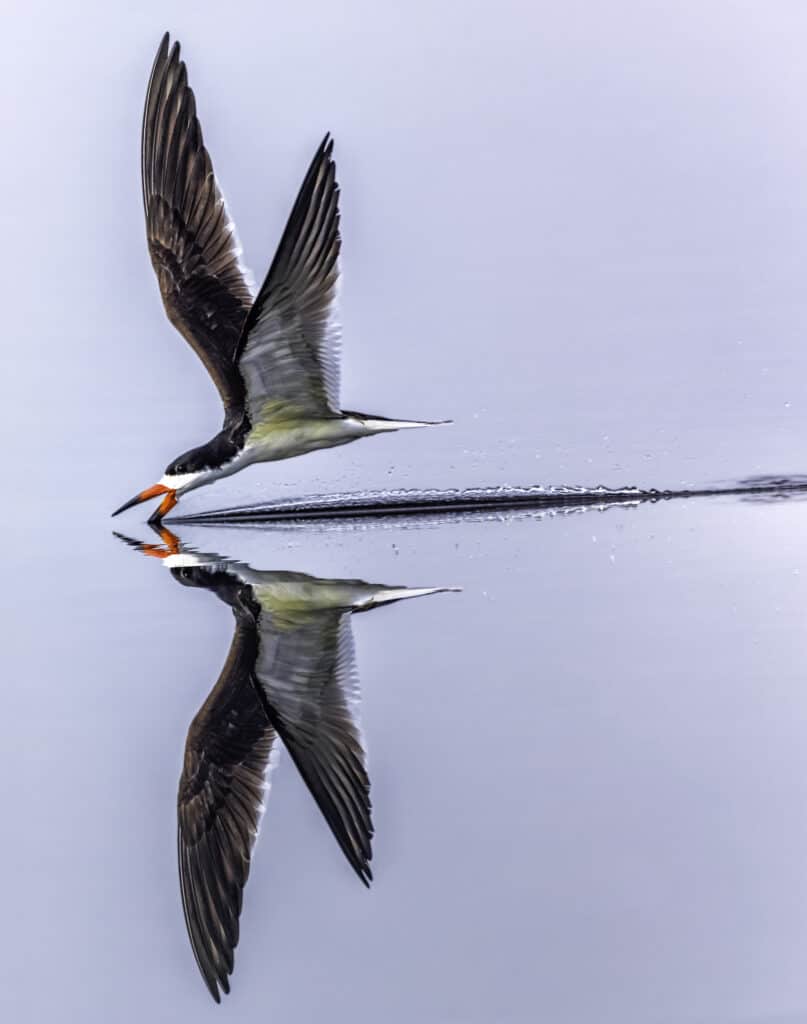
Black skimmers typically fly low above the water, furrowing with their lower beak.
©iStock.com/Natures_Vision
The black skimmer, Rynchops niger, is a long-winged bird found strictly on the coastal marshes in North America. You can spot the birds resting on sandbars or beaches. Black skimmers breed in loose groups along the Gulf of Mexico coast before migrating south to the Caribbean and South America.
The bird is distinctively bi-colored, white underneath and black on its wings and back. Its beak is also bi-colored, with the basal half red and the rest black. Additionally, the upper bill is shorter than the lower bill. Black skimmers also have short, orange-colored legs.
Black skimmers typically forage in large groups, flying low above the water and furrowing with their lower beak. The bird then snaps shut the upper beak once contact is made with a fish or crustacean. The diet typically includes small fish, mollusks, crustaceans, and insects.
Stingrays
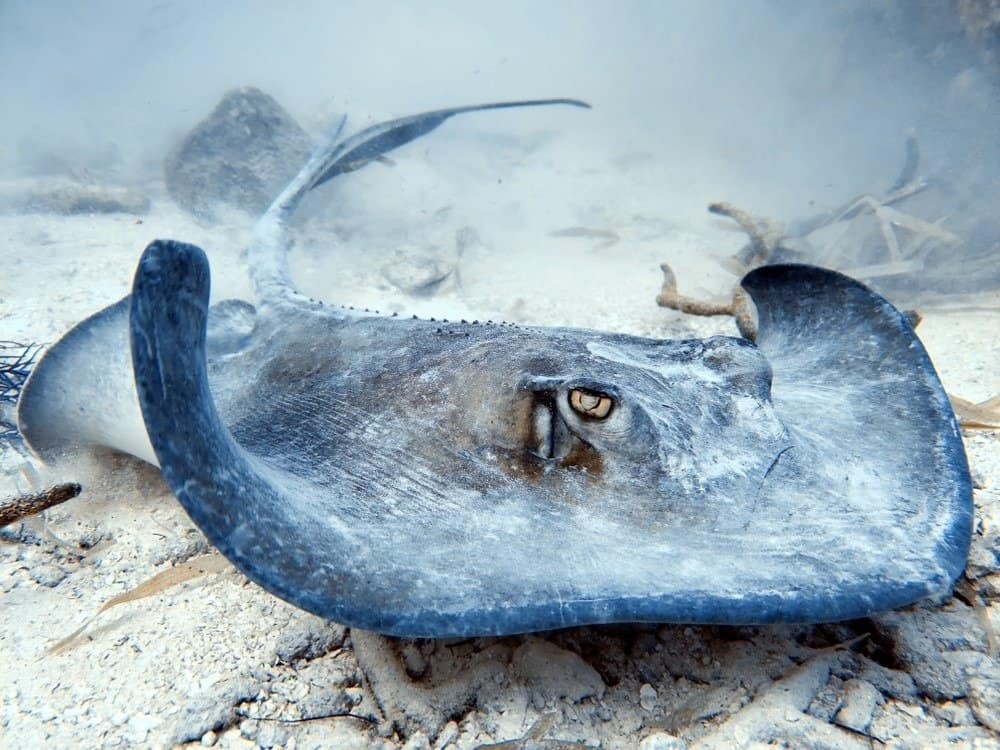
Stingrays can be found in the Last Island waters and are considered one of the most dangerous creatures in Louisiana.
©Nate Madden/Shutterstock.com
Another creature that lurks in the Last Island waters is the Stingray. Stingrays prefer a saline, brackish, coastal water habitat 6 to 20 feet deep. They are bottom dwellers, hiding in soft mud or sand marshes to avoid predators.
Stingray species that live within the barrier islands are Atlantic, bluntnose, southern, and yellow stingrays. The Stingray has a pair of pectoral fins that it uses to move around. It has a long tail with a stinger.
The stinger makes stingrays one of the most dangerous creatures in Louisiana. The spines at the tip of the tail are venomous, with a slight cut causing swelling and extreme shock to the victim.
Herons
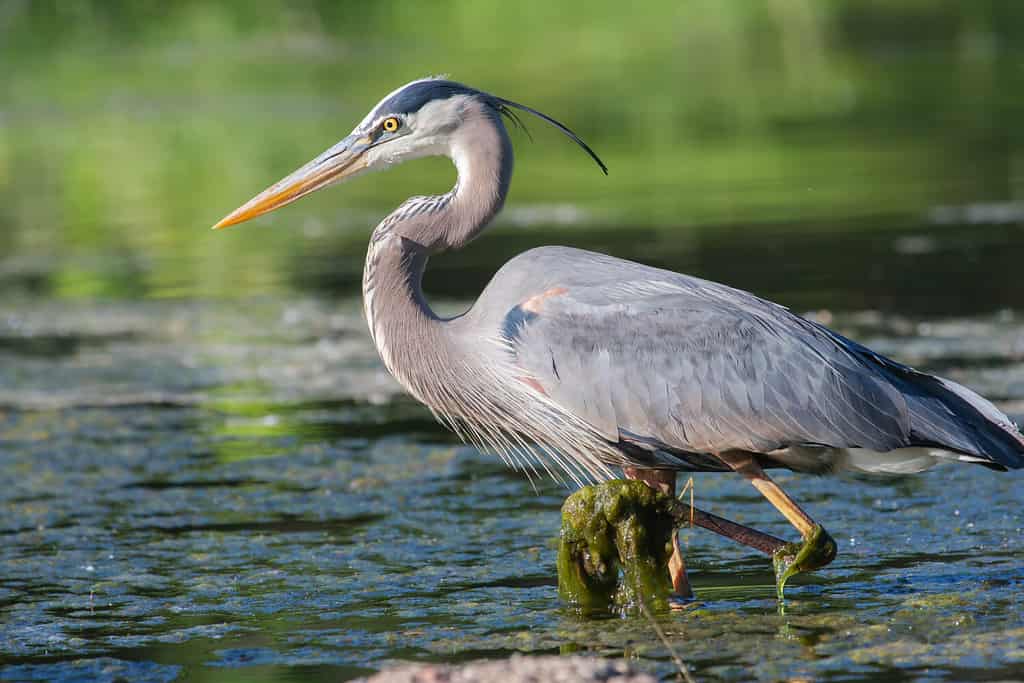
Great blue herons have greyish-blue bodies and long grey necks.
©Joseph Scott Photography/Shutterstock.com
Herons are long-legged birds with straight-pointed beaks. They love to live in shallow waters across the U.S. The birds typically migrate to the coastal marshes to breed. Common heron species in the state include great blue heron, American bittern, green heron, snowy egret, and reddish egret.
Great blue herons can be spotted throughout the year, with greyish-blue bodies and long grey necks being the distinctive features. Snowy egrets are small all-white herons with black bills, long black legs, and bright yellow feet.
Green herons prefer coastal marshes and have a glossy green-black coloring. Reddish egrets are near-endangered heron species that live all year along the Gulf Coast, East Coast, and Mexico. The species has a dusky pink and grayish-blue body tone.
Black Drum
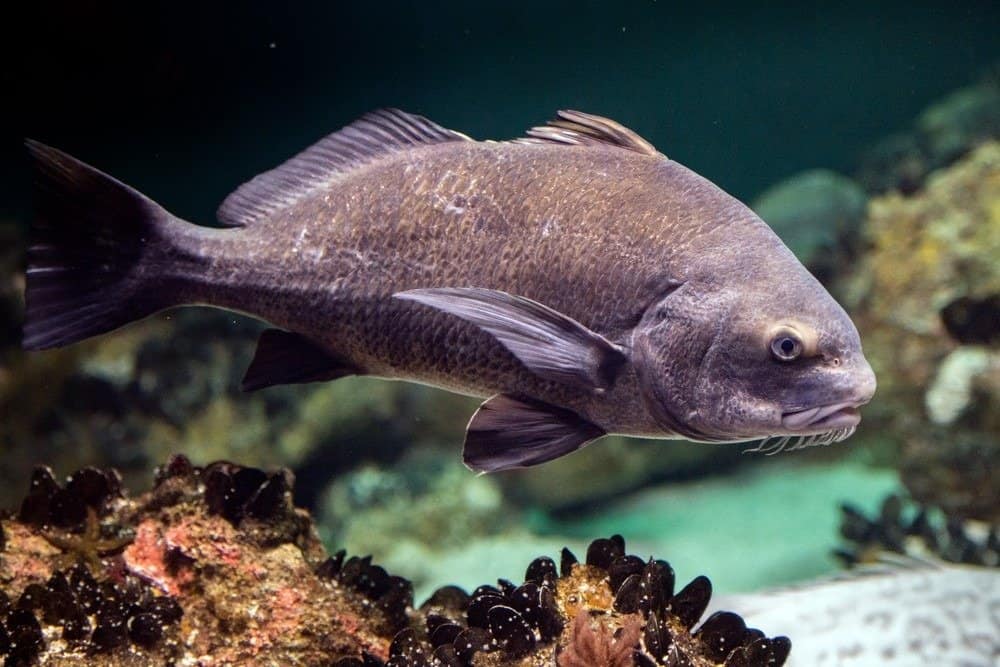
Black drums use their chin equipped with vibrissa and whiskers beneath their lower jaw to detect their prey.
©Andrea Izzotti/Shutterstock.com
Commonly identified as a drum or drummer, the black drum is a chunky, high-backed saltwater fish. The bottom-dwelling fish is silver-grey or black. Younger fish have four or five dark vertical bars that disappear with age. The fish reaches six inches within the first year, twelve in the second, sixteen in the third, and continues to grow two inches per year.
Black drums primarily rely on a diet comprising crustaceans and mollusks, including clams, oysters, and crabs. They use their chin equipped with vibrissa and whiskers beneath their lower jaw to detect their prey.
When feeding, they assume a head-down position and generate small craters on the seabed. With robust dental plates, they can crush open tough shells. The most substantial black drum ever recorded weighed in at 146 pounds.
Blue Crab
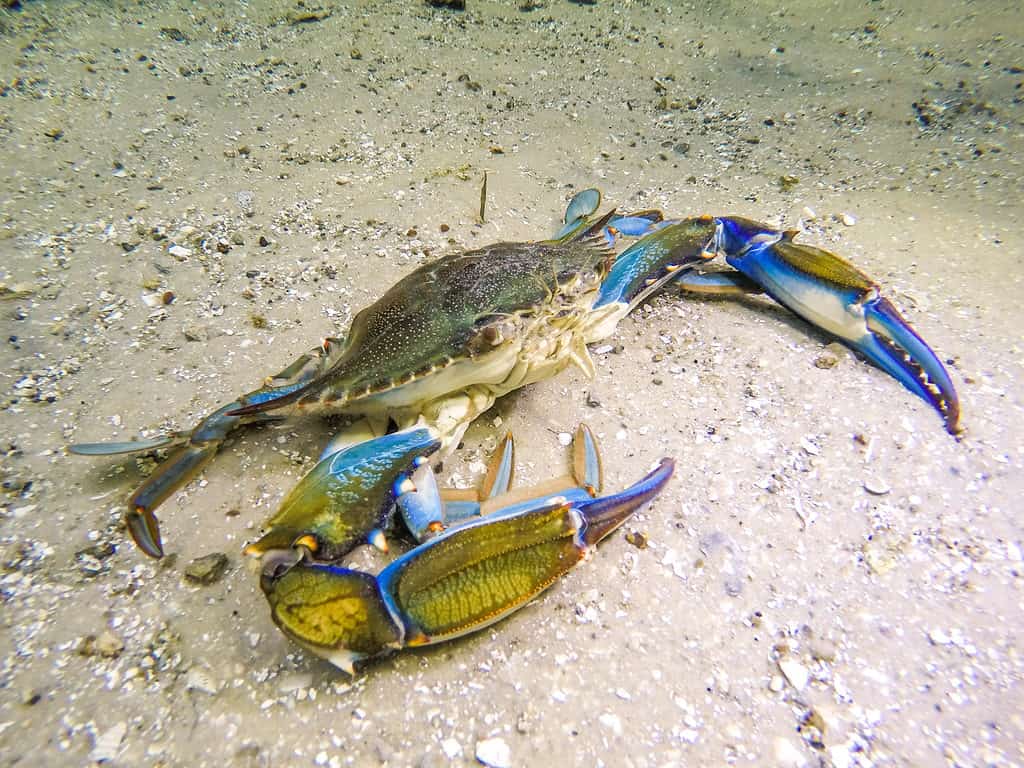
Louisiana is the largest blue crab producer in the nation.
©Jen Helton/Shutterstock.com
The blue crab is a highly sought-after shellfish that lives along the Atlantic coast and the Gulf of Mexico. Louisiana is the largest blue crab producer in the nation, with more than half harvested from the Lake Pontchartrain and the Terrebonne Basins. The Last Island is part of the Terrebonne Basin.
The blue crab has pincer-like claws used to catch prey, shred food particles, and protect against predators. Juveniles are typically found in estuaries, marshes, and soft mud bottoms. Adults are distributed across freshwater, shallow oceanic, and estuarine waters.
Blue crabs usually feed on plankton but sometimes ingest larger prey such as snails, clams, shrimp, and oysters. It’s worth mentioning their cannibalistic tendencies since scientific investigations have shown that blue crabs account for around 13% of their fellow blue crabs’ intake.
Jellyfish
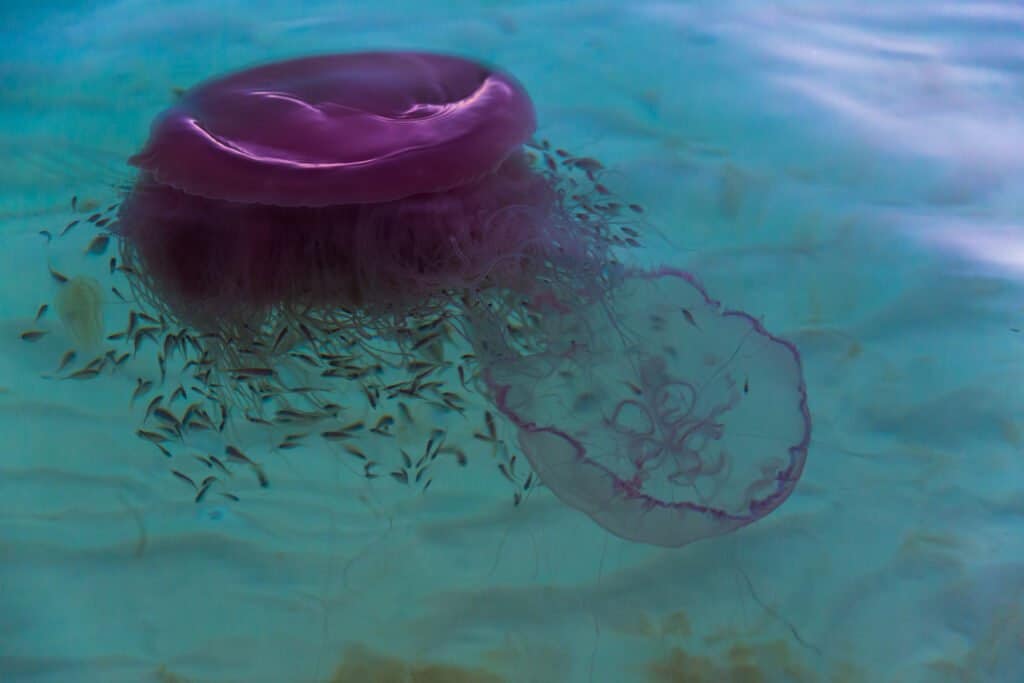
Pink meanie jellyfish as well as moon, cannonball, Atlantic sea nettle, and comb jellies are some of the common jellyfish species found around the Louisiana coast.
©iStock.com/olya_steckel
Multiple species of jellyfish inhabit the Gulf of Mexico and the waters surrounding the Terrebonne barrier islands. Distinguishable from the umbrella-shaped bells and trailing tentacles, jellyfish are exclusively marine, except few hydrozoan species.
Some common jellyfish species around the Louisiana coast include moon jellyfish, pink meanie, cannonball, Atlantic sea nettle, and comb jellies. Jellyfish are typically carnivorous, feeding on crustaceans, small fish, fish eggs, and other jellyfish.
Human encounters with jellyfish can have varying results, from mild sting irritations from a moon jelly to painful venomous stings from Portuguese man-of-war.
Gulf Salt Marsh Snake

The Gulf salt marsh snake is pale tan or grey above, with three broad, dark brown, or black longitudinal stripes.
©Jay Ondreicka/Shutterstock.com
The Gulf salt marsh snake (Nerodia clarkii) is a non-venomous aquatic snake and is one of the creatures that lurk in coastal salt marshes and brackish estuaries. The flat-headed snake can grow up to 15 to 30 inches. All members of the species are ovoviviparous, giving birth to live young.
The Gulf salt marsh snake is pale tan or grey above, with three broad, dark brown, or black longitudinal stripes. The underside is a dark, reddish brown with a central line of pale spots. It also has a dark band through the eye.
The snake can be seen swimming in the water, slithering in the marshes, or sunbathing. Specifically, fish, frogs, crabs, and shrimp make up the snake’s diet. Gulf salt marsh snakes are typically nocturnal, foraging at night when the tide is low.
Redfish
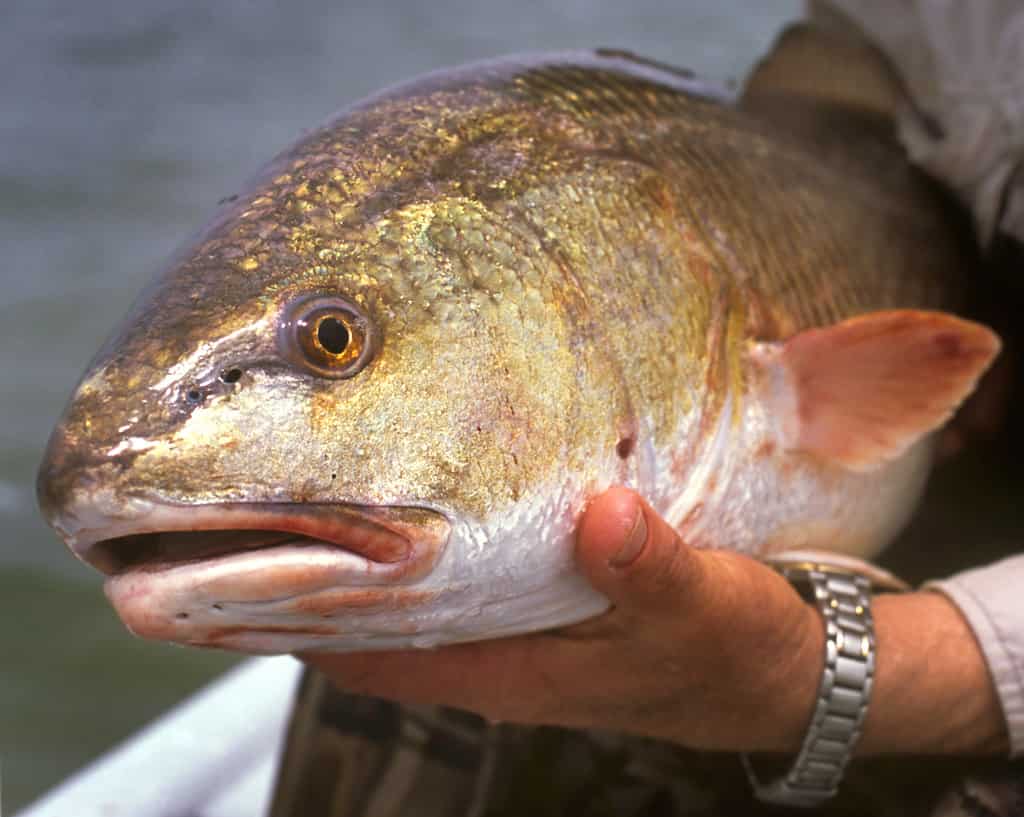
Redfish, also known as red drum, are popular targets for fishermen due to their light flavor when cooked.
©iStock.com/SteveClever
Redfish, or red drum, is a saltwater game fish found along the Atlantic coastline and the Gulf of Mexico. The fish prefer shallow waters, from one to four feet deep. They can be found in water so shallow that their backs remain exposed. The redfish hide in the seagrass and on muddy or sandy bottoms in winter.
Red drums are copper-bronze, fading to a light gray belly. It also has one or more dark spots near the tail fin. The strong pharyngeal teeth crush oysters and other shellfish that it feeds on.
Juvenile red drums are typically inshore species that return to oceanic waters after three to four years. The fish are prolific spawners, producing tens of millions of eggs. Red drums are a favorite target for fishermen due to their light flavor when cooked.
Gull-billed Tern
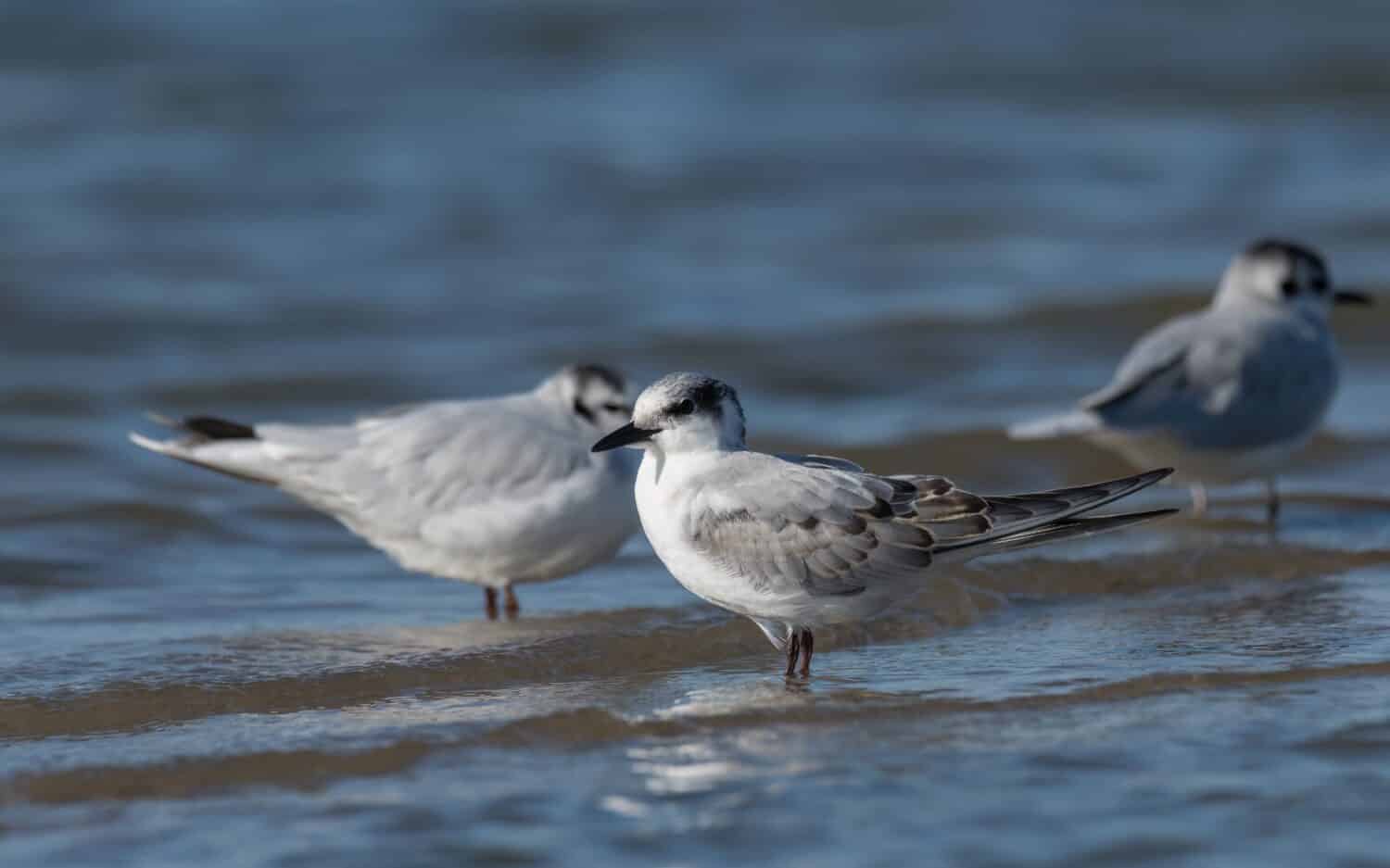
Gull-billed terns establish breeding colonies in marshes, lakes, and coastal shores, which explains their occurrence at Last Island.
©MMCez/Shutterstock.com
A gull-billed tern is a medium-sized tern that loves to swoop over salt marshes and beaches graciously. The bird has white underparts and an upper grey body with a black cap, legs, and beak. Gull-billed terns have a 30-36 inch wingspan and weigh 5.3–10.3 ounces.
Gull-billed terns establish breeding colonies in marshes, lakes, and coastal shores, which explains their occurrence at Last Island. These birds construct their nests in shallow depressions, laying three to five eggs.
Distinguishing themselves from other tern species that predominantly rely on fish, gull-billed terns exhibit a diverse diet that includes insects, small mammals, and amphibians. Additionally, they exhibit opportunistic behavior by pilfering food from other birds and preying upon the chicks of other avian species.
Spotted Seatrout

A spotted seatrout is easily identifiable by its canine teeth and an elongated dorsal fin that has a deep notch separating the fin.
©IrinaK/Shutterstock.com
The spotted seatrout is another creature that lurks along the Last Island marshes. Also identified as the speckled trout, the fish live on shallow grassy flats across the coastal waters or salty wetlands.
The fish is easily identifiable from its prominent canine teeth. It also has an elongated dorsal fin with a deep notch separating the fin. Spotted sea trout have a silvery hue with irregular black spots on their upper half.
The fish feed on shrimps, crustaceans, and fish. Males produce a “drumming” sound to attract females during the mating season. According to the National Oceanic and Atmospheric Administration, spotted sea trout are among the top ten species sought after in recreational fishing within the U.S.
Environmental Threats and Conservation Efforts
While the Last Island is a rich ecosystem with numerous creatures that lurk on its marshes and surrounding waters, it faces a more significant ecological threat due to erosion and multiple hurricane strikes. It is alarming to note that Louisiana loses an average of 16 square miles annually. Rising sea levels, lumbering, and oil dredging are pivotal causes for this erosion of the coastal marshes.
Various organizations like the National Audubon Society and the Louisiana Department of Wildlife and Fisheries come together and play a crucial role in the conservation efforts. They work towards protecting and restoring bird habitats, sustainable fishing practices, and preserving coastal habitats and biodiversity.
Restoration projects focused on stabilizing the Island’s coastline, planting vegetation to minimize erosion, and creating artificial reefs to preserve the natural habitats are crucial to protecting the numerous species that call Last Island home.
Discovering the Remarkable Wildlife On Louisiana’s Largest Deserted Island
Last Island, an inhabited wildlife refuge off the coast of Louisiana, unveils a world of enigmatic wildlife. From graceful birds that soar above the salt marshes to the mysterious crustaceans and fishes in the waters, the Island is a tapestry of biodiversity waiting to be explored.
The state allows birding, picnicking, fishing, and overnight camping on Trinity Island. Public access on other parts of the Island requires permits from the Louisiana Department of Wildlife and Fisheries.
You can participate in conservation efforts to help protect the thirteen animal species highlighted in the post. Through dedicated conservation efforts, preserving Last Island’s natural treasures will continue to safeguard these remarkable creatures for generations to come.
The photo featured at the top of this post is © Bonnie Taylor Barry/Shutterstock.com
Thank you for reading! Have some feedback for us? Contact the AZ Animals editorial team.






